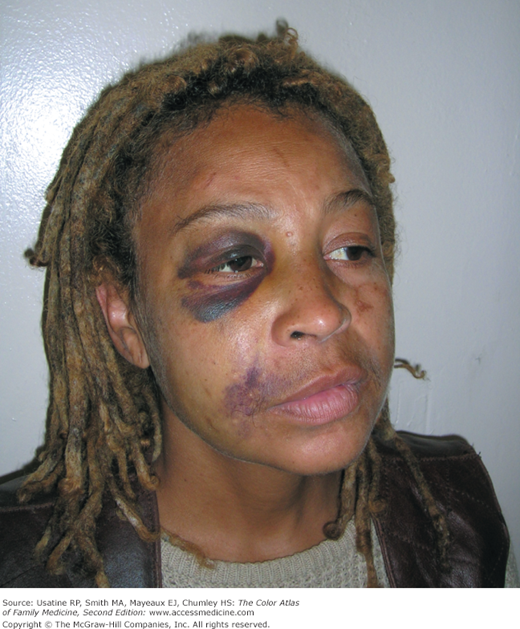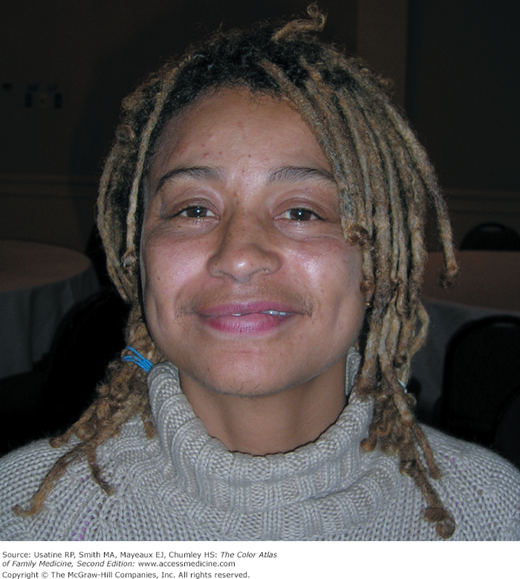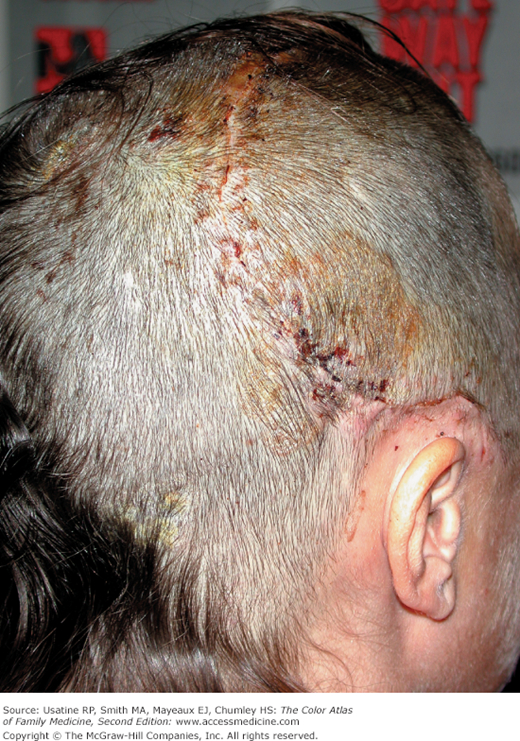Patient Story
A woman who fled her abusive boyfriend is observed sitting at a table with other women in a residential chemical dependency treatment program. Her bruised face could not be missed (Figure 10-1). The program physician asked to speak with her and learned that her boyfriend beat her when she told him that she was voluntarily entering this program. The boyfriend was also an addict and had been physically abusive to her before. The violence escalated when she said that she needed help to stop the alcohol and drugs. She left him and did not believe that he would follow her. The program management assured her that they would not let him on the premises and would do all they could to keep her safe while she was recovering. Figure 10-2 was taken 2 months later, when her face was healing along with her mind and spirit. She completed the 90-day program and is currently working and actively following a 12-step program.
Figure 10-2
Photograph of the woman in Figure 10-1 taken 2 months later. Her facial and psychological wounds are healing. (Courtesy of Richard P. Usatine, MD.)
Introduction
Intimate partner violence (IPV) is defined as an intimate partner’s physical, emotional, or sexual abuse. Physical violence is the intentional use of physical force with the potential for causing death, disability, injury, or harm. Physical violence includes scratching; pushing; biting; punching; use of a weapon; and use of restraints or one’s body, size, or strength against another person.1
Epidemiology
- An estimated 4.9 million IPV rapes and physical assaults occur each year among U.S. women (age 18 years and older) and 2.9 million assaults occur among U.S. men. Most of these assaults include pushing, grabbing, shoving, slapping, and hitting and do not result in major injury.3 In a national telephone survey of 8000 women and 8000 men, 41.5% of the women who were physically assaulted by an intimate partner were injured during their most recent assault, compared with 19.9% of men.4
- Physical violence by an intimate partner can result in direct injury including death (1181 women and 329 men in 2005; Bureau of Justice, 2007), adverse psychological, and social consequences, and impaired endocrine and immune systems through chronic stress and other mechanisms.4
- In the family practice setting, the lifetime prevalence of abuse of women was 38.8%, with current abuse reported by 2% to 48% of women.1
- A national survey estimated that 503,485 women and 185,496 men are stalked by intimate partners each year.4
- Clinicians identify only a small number of victims (1.5% to 8.5%).1 Only approximately 20% of IPV rapes or sexual assaults, 25% of physical assaults, and 50% of stalking directed toward women are reported; fewer events against men are reported.4
- Between 4% and 8% of women are battered during pregnancy.5
- According to the National Violence Against Women Survey, more than 200,000 women age 18 years and older were raped by intimate partners in the 12 months preceding the survey.6
- Annually, 10 million children witness wife-battering.1 Children may become injured themselves. One study found that children of abused mothers were 57 times more likely to have been harmed because of IPV between their parents, compared to children of nonabused mothers.7
Risk Factors
- Individual factors—Individual factors include prior history of IPV, witnessing or experiencing violence as a child, being female, young, pregnant, less educated, unemployed, heavy user of alcohol or illicit drugs, mental health problems (e.g., depression, borderline or antisocial personality traits), and engaging in aggressive or delinquent behavior as a youth.
- For women, having a greater education level than their partner, being American Indian/Alaska Native or African American, and having a verbally abusive, jealous, or possessive partner increased risk. In addition, a risk of IPV by either a past or a new offender was almost double for women who had recently changed residence compared with those who had not moved.9
- For men, having a different ethnicity from their partner’s increased the risk of IPV.
- Relationship factors—Relationship factors include couples with income, educational, or job status disparities or in which there is dominance and control of the relationship by one partner over the other, and marital conflict or instability.
- Community factors—Community factors include poverty and associated factors or weak community sanctions against IPV (e.g., police unwilling to intervene).
Diagnosis
Asking patients directly about violence at routine visits or when presenting with clues (as below) is recommended by some for identifying patients suffering from IPV,1,4 SOR C although data are lacking that identification produces positive outcomes. It is important to use patient-centered approaches.
- Questions that may be asked include general questions about how things are going at home or more specific questions about experiences of nonviolent (e.g., insulting, threatening) or violent (e.g., grabbing, punching, beating, forced sex) abusive acts.
- Several self-administered instruments are available for detecting IPV including the Woman Abuse Screening Tool (WAST).10 In a study of screening tools, women preferred self-completed approaches (versus face-to-face), although no differences in prevalence was found for method or screening instrument.11 In a predominantly Hispanic population, investigators found the Spanish version of the 4-question instrument HITS (Hurt-Insult-Threaten-Scream) to be moderately reliable with good validity compared with WAST for Spanish-speaking patients12; HITS has also been validated with male victims.13
Clues on patient history include the following:
- Chronic pain syndromes (e.g., headache, backache, stomachache, or pelvic pain).
- Depression.
- Drug and alcohol abuse.
Up to 42% of women and 20% of men who were physically assaulted as adults sustained injuries during their most recent victimization.3 Clues on physical examination:
- Physical injury—Most physical injuries are minor (e.g., contusions, lacerations, abrasions) but include broken bones, traumatic brain injury, and knife wounds (see Figures 10-1, 10-2, and 10-3).
- Ocular injuries can include soft-tissue injuries, corneal abrasions, orbital fractures, lens dislocation, retinal detachment, visual field loss, double vision, and blindness (see Figure 10-1).
- Trauma to the mouth and lips may be accompanied by fractures, broken teeth, tongue lacerations, and altered taste and smell.
- Injuries suspicious for abuse are those only in areas covered by clothing, injuries in different stages of healing, and injuries that show a defensive wound pattern particularly on the hands or arms.
- Upper torso injury carries a high risk of injury to cervical spine, large vessels of the neck and chest and lungs.
- Ocular injuries can include soft-tissue injuries, corneal abrasions, orbital fractures, lens dislocation, retinal detachment, visual field loss, double vision, and blindness (see Figure 10-1).
- Depression or symptoms of posttraumatic stress disorder (e.g., emotional detachment, sleep disturbances, flashbacks, replaying assault in mind).
- Evidence of forced sexual assault.
- Presence of sexually transmitted infections.






